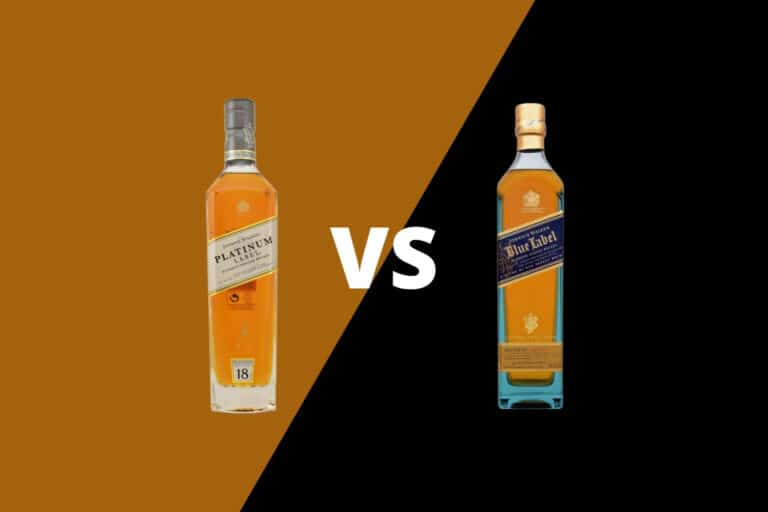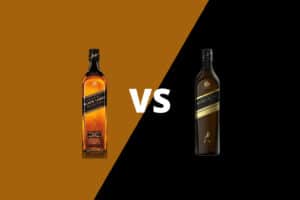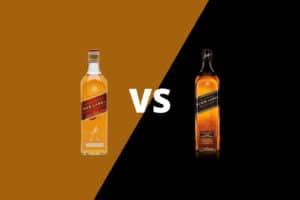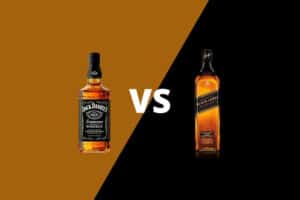The Johnnie Walker portfolio includes a color-coded range that is widely available and globally distributed. These products include (from low to high-cost): Johnnie Walker Red Label, Black Label, Double Black, Green Label, Gold Label Reserve, Platinum Label 18-Year-Old and Blue Label.
We have already looked at Red and Black Label, along with a Black vs. Double Black matchup. Today, we look at the high end of the Johnnie Walker range — the Platinum Label and Blue Label products.
Table of Contents
History
The history of John Walker and the brands he developed along with his son Alexander Walker and grandson John Walker II has been chronicled in previous installments on our website. That history chronicles the story of one of Scotland’s first families to blend single malts from the many small distilleries that dot the northern highlands, coasts and islands with the mellow and inexpensive grain whiskies from the country’s Lowlands. That first product was called Walker’s Old Highland and eventually morphed into the color-coded portfolio we know today.
This post focuses on the high-end of the product range, the Platinum and Blue labels.
The predecessor to Blue Label was a product called ‘Oldest,’ released in 1987 and replaced when Johnnie Walker Blue Label was launched in 1992. And Johnnie Walker Platinum 18 Year Old was released in 2012.
The whisky world in 1992 was a very different place from today. When Johnnie Walker Blue Label hit the shelves at about $150, it would’ve been the only whisky available at that price point in nearly every liquor store in America, and customers would have to search high-end cognac products to find anything else in that price range.
In the 1990s, the whisky renaissance we’ve become accustomed to was still a bit over the horizon. At the time, customers were just beginning to come around to what had long been considered an old man’s drink — whisky. But executives at Diageo spotted a promising demographic emerging — the aspirational whisky drinker. This was a customer who wasn’t only interested in a good dram, but all that came with it.
Have you ever been to an exclusive, velvet-roped nightclub? Whether it be in Miami, New York or Las Vegas, some of the experience is universal. Part of that experience is the idea of bottle service — bartenders who bring out the bottles with sparklers and fanfare to your table show everyone within eyesight there’s a big spender in the house.
The psychology behind why people will spend $300 for a $30 bottle of vodka to make their table the center of attention at a crowded nightclub is not too far from the appeal that makes ultra-premium brands like Johnnie Walker Blue Label work. When you order a dram at the bar, it’s a head-turner, and when you gift a bottle to a client, it’s a memorable impression.
Today, many brands take a page out of the ‘good, better, best’ playbook that the Johnnie Walker brand pioneered when they launched Walker’s Old Highland bottling in 1857.
Mashbills
The term mash bill is used to describe a whisky’s list of grain ingredients. These grains are ground — or ‘mashed’ — into a solution with water, cooked and cooled before yeast is added to make a fermented type of beer.
The ‘wort’ produced by Scottish distillers has a few notable differences from most types of American beer used in whiskey production. In Scotland, this liquid is lautered to remove the solids from the opaque wort liquid, which is used to charge the still.
There are five classifications of scotch whisky: single malt scotch, single grain scotch, blended scotch, blended malt scotch and blended grain scotch.
Single malt scotch whisky products must be made from 100 percent malted barley. Single grain scotch whisky products can be made from various grains, a proportion of which will contain malted barley. The ‘single’ in both single malt and single grain is not a reference to the mash bill but an indicator that the whisky was made at a single distillery.
If a product is labeled as a blended scotch whisky, it is nearly always a combination of single malt and single grain whiskies blended to create a specific flavor profile.
We will discuss the distillation differences between single malt and single grain whiskies in the next section.
Both Johnnie Walker Platinum 18 Year Old and Johnnie Walker Blue Label are blended scotch whiskies. They are produced by combining single malt scotch whiskies made at various Diageo plants across Scotland with the single grain whiskies made at its large Lowland distilleries.
Diageo operates about 28 distilleries across Scotland, many producing whisky casks utilized for Johnnie Walker products. These include single malts like Clynelish, Talisker, Caol Ila, Lagavulin, Oban, Glendullan, Dufftown, Glen Ord, Glenkinchie, Craagganmore, Mortlach, Royal Lochnagar, Glen Elgin, Dalwhinnie, Glenkinchi, Inchgower and Cardhu. The large single grain distilleries in Diageo’s portfolio include the massive Cameronbridge Distillery north of Edinburgh, the home of Haig Club Single Grain Scotch Whisky.
Distillation & Production
Single malt scotch distilleries range from historic 18th-century buildings to gleaming, brand-new modern buildings launched among the current craft whiskey renaissance. However, all single malt distilleries have one thing in common: copper pot stills, which are required when making single malt whisky.
Compared to the historic single malt distilleries, grain distilleries are large industrial sites that pump out a lot of production. In addition to making malt whiskies, many also produce other distilled spirits such as vodka and gin. In terms of volume scale, these grain sites might resemble the large distilleries in North America located in Kentucky and across Canada, while Scotland’s single malt distilleries resemble a sort of predecessor to today’s larger American craft distilleries.
Single grain distilleries often utilize large column stills to operate a continuous distillation operation in which terminal wort is fed into one end, and clear distillate is pulled from the system at the other. These operations can run 24 hours, 7 days a week and may only stop for maintenance and repair. Scotch grain components are almost always made with corn or wheat — an input often determined by commodity grain price — and distilled to the relatively high 94.8 percent alcohol by volume allowed by UK regulations. This produces a mild and mellow whisky profile the blender will combine with the flavorful single malt components to create a range of final blended products.
In September 2021, Diageo launched the Johnnie Walker Experience building in Edinburgh to take advantage of the growing scotch tourism trend. However, readers should note this is not an active production facility but rather an immersive multimedia experience used as an educational tool to educate guests about the brand’s history and tradition.
Maturation
This is one of those cases in which a non-age statement (NAS) whisky is more elevated and mature than its age statement counterpart — which is significant when you’re going against an 18-year-old bottle of scotch!
In this instance, the NAS Blue Label offering is the more premium blend compared to Platinum Label — containing barrels that are hidden gems in the massive constellation of warehousing complexes that make up Diageo’s maturation facilities. Although there is no age statement, Master Blender Dr. Jim Beveridge has claimed publicly that barrels up to 60-plus years old are utilized when blending Blue Label.
Ownership, Price Point & Value
A bottle of Johnnie Walker Blue Label Blended Scotch Whisky will run you about $239 for 750mL at 80-proof, or 40-percent alcohol by volume.
A bottle of Johnnie Walker Blended Scotch 18 Year Old will run you about $94 for 750mL at 80-proof, or 40 percent ABV.
Other Johnnie Walker core range products include Johnnie Walker Gold Label Reserve, Johnnie Walker Green Label, Johnnie Walker Double Black and Black Label, and the introductory Johnnie Walker Red Label.
Readers outside the United States may be familiar with Johnnie Walker Swing, a blended scotch product in a rounded glass bottle.
And the expressions don’t stop with the core range. Dr. Jim Beveridge and his blending team are big on innovation. They’ve introduced the ultra-premium John Walker & Sons line, which includes XR 21 Years Old, Odyssey, King George V and The John Walker exclusive blends collection to take advantage of the ultra-premium travel retail segment. And a host of limited-time releases, including White Walker — a Game of Thrones edition released during the final season of the HBO series — and Jane Walker — a blended scotch product blended by Emma Walker and championing Cardhu single malt, which is run by Elizabeth Cumming.
Flavor Profile
Johnnie Walker Platinum 18 Year Old Blended Scotch Whisky
Description — In the glass, Johnnie Walked Platinum Label has an amber-sherry color and moderate legs at 80-proof.
Nose — Syrupy, meaty cereal, nuttiness with sandalwood and maple.
Palate — Malty, vanilla and oak, oily mouthfeel with tobacco, cinnamon, raisins notes and lingering medicinal smoke. Buttery.
Finish — Vanilla, coconut, a bit of bonfire smokiness and spicy cinnamon notes.
Johnnie Walker Blue Label Blended Scotch Whisky
Description — In the glass, Johnnie Walker Blue Label is also amber-sherry in color with moderate legs at 80-proof.
Nose — Iodine and peat, oak and sherry, corn sweetness, ripe fruit, raisins, toffee, honey, cigar box and sandalwood.
Palate — Clean barley, complex and deep, oak, coconut, fudge, leather, toffee and honey.
Finish — Tobacco, leather, honey, figs, toffee, honey, sweet sherry and peaty smokiness.
Verdict…
Do the math. What’s it worth to you?
In this case, the price points for these two bottlings take the guesswork out of it. These two products make up the high end of the Johnnie Walker core range. A side-by-side tasting offers a lot of educational value in introducing the idea of premiumization. And it offers a great introduction to the ultra-premium John Walker & Sons range.

















